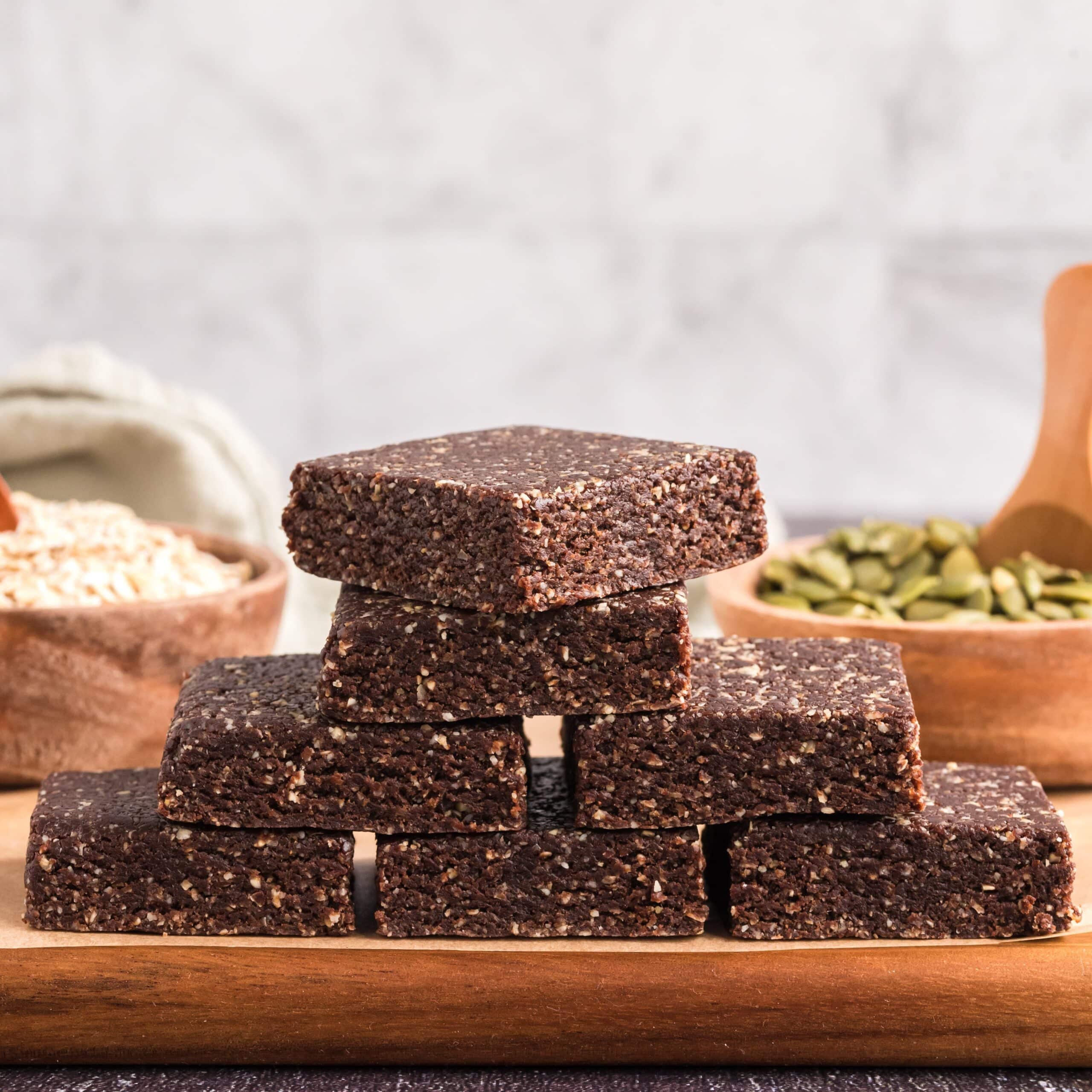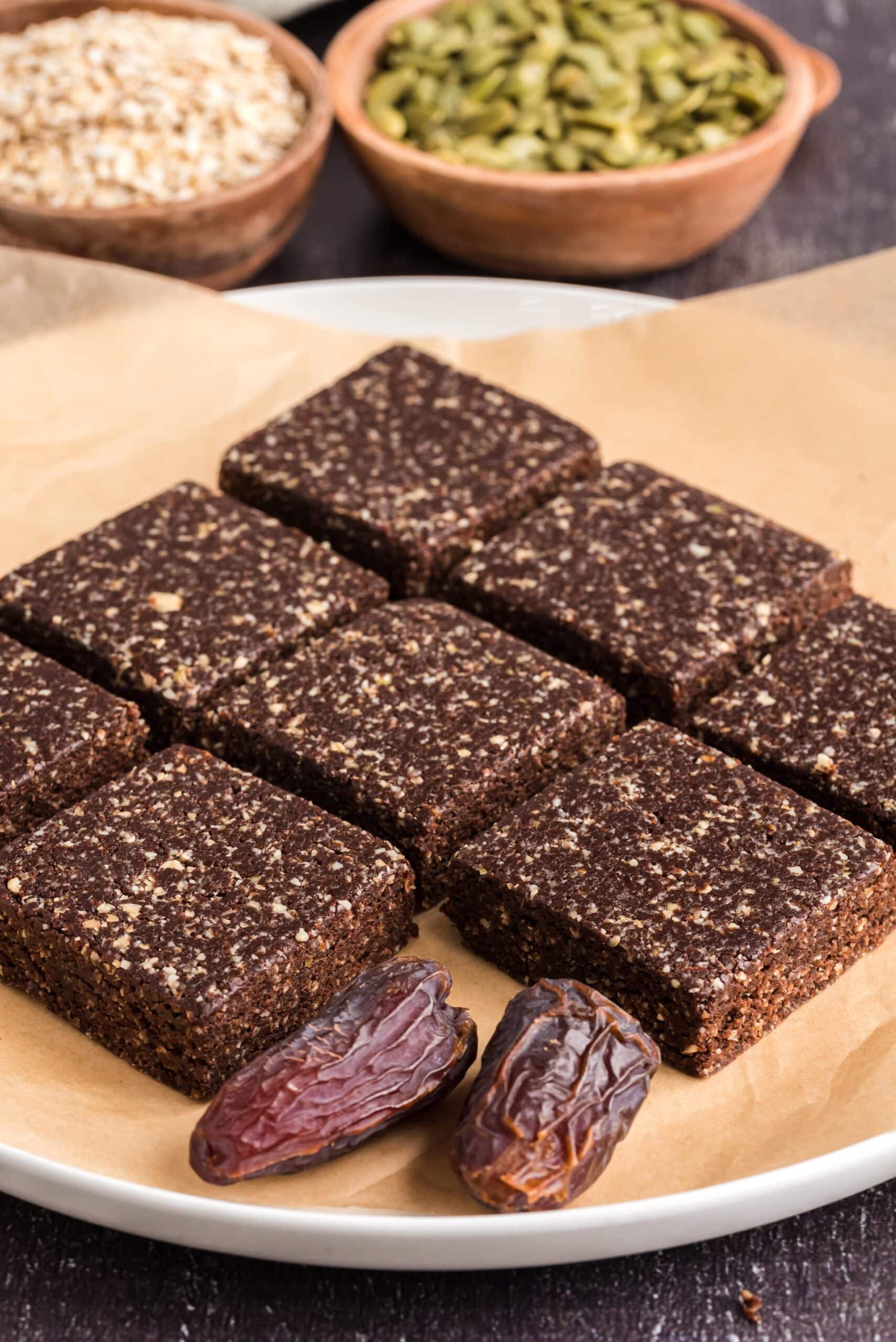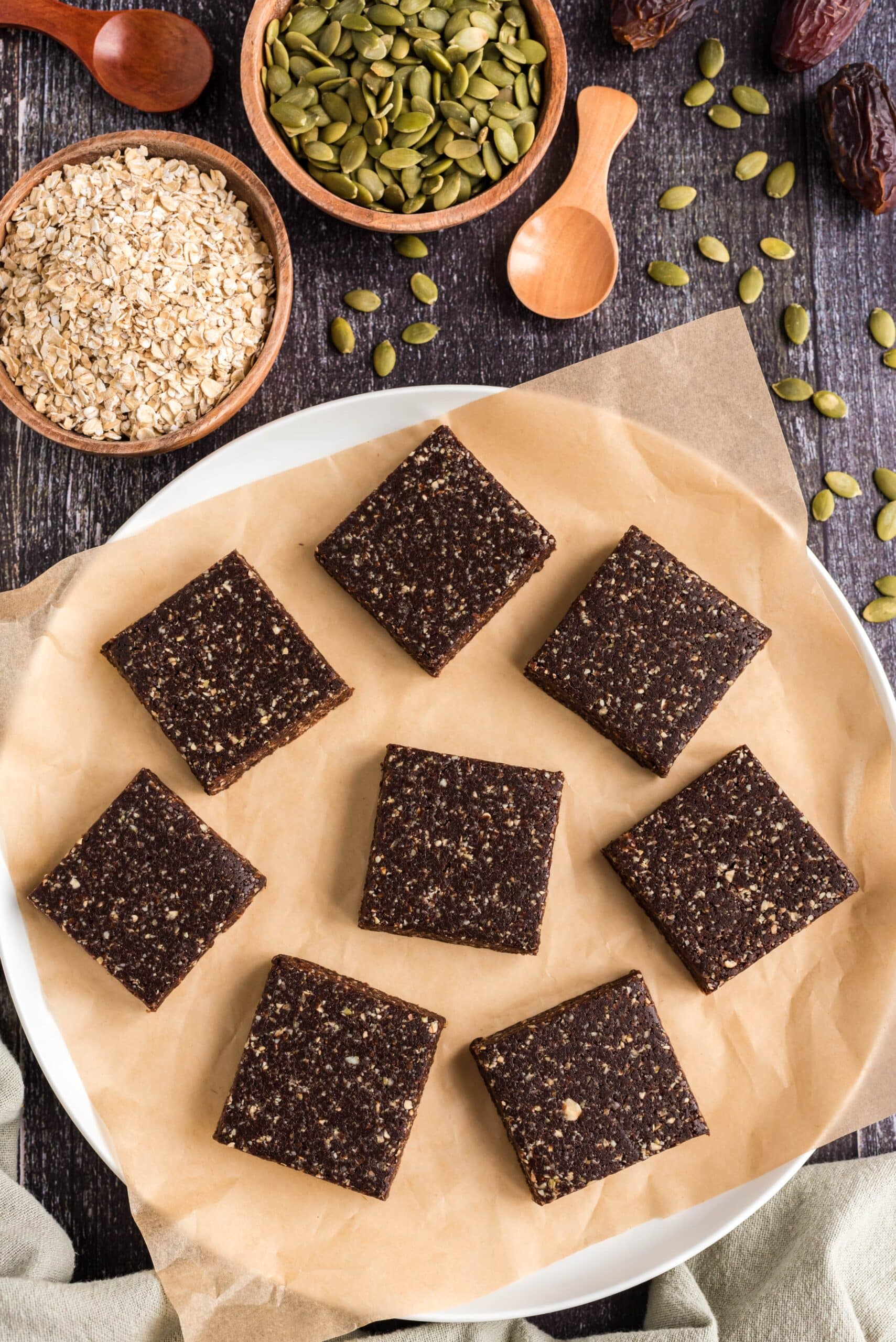These homemade vegan protein bars are delicious, made with wholesome ingredients, and sweetened only with dates… and have NO pea protein. 🙌
What’s the problem with pea protein? Read on…

Vegan protein bars have become big business. Search online and you will find so many options for vegan snack bars and plant-based protein bars.
These snack bars vary greatly in ingredients. I think LaraBar probably originated the plant-based snack bar. While not a “protein bar” per se, they have whole foods ingredients and protein coming from nuts and seeds.
With the big growth in vegan foods, more plant-based snack bars have emerged. Some staying in line with that Larabar formula of a healthy snack bar. Then, others with the purpose of offering a protein bar that is vegan – free from animal ingredients normally in protein bars (mainly egg whites and whey protein).
I enjoy a vegan snack bar. Sometimes just half a bar. One of my favorites years ago was Mid-Day Squares. However, they recently changed their formula to include pea protein. And that leads me to today’s post, and this video.
Introducing Dreena’s “No Pea-Protein” Vegan Protein Bars
So I created my own vegan protein bars. And I think they are delicious! They have a satisfying chew and aren’t too sweet (I use a modest amount of dates to sweeten).
But why the funny name?

A few years ago I experienced inflammation in my body. Not in just one joint, but in all my joints. My naturopath recommended some food testing.
Among the high-offending foods? Mustard seed, sunflower, corn, and peas.
Peas? They seem such friendly food! And organic green peas are one of my favorites. They seem so innocuous. How could they be one of the big culprits?

I thought peas would be the easiest to remove. Unlike mustard, which I use in salad dressings, or corn which we enjoy in the form of polenta or snack crackers. Peas seemed the easiest to eliminate – just stop eating green peas, right? Not so.
It’s surprising how many vegan foods have pea protein
Pea protein is not just in vegan protein powders (and it is in most plant-based protein powders). Look at your labels. Much like sunflower (which is used in small amounts as sunflower lecithin or sunflower oil in everything from supplements to crackers), pea protein is making its way into so many foods.
Every time I food shop, I check labels of new vegan products. MOST have pea protein. But it’s not just vegan products like vegan yogurts, vegan milks, and vegan snack bars. It’s also in products like granola, cereal, snack bars marketed for children. It’s also in vegan ice cream! Why does a non-dairy ice cream need pea protein? It doesn’t. But these companies are using it as a nutritional “bump” for their labelling.
Take a look at macadamia nut milk, vegan greek yogurts, and all So Delicious ice creams. Pea protein.
Perhaps that macadamia milk or vegan greek yogurt would be “low” in protein naturally, but with the addition of pea protein, it has a respectable protein count.

This is unfortunate because the products don’t need the protein source to be added. But manufacturers know that consumers are looking for higher protein profiles – it seems we still have some protein inadequacy concerns.
To be clear, protein is not a concern in a whole foods vegan diet. When eating a variety of foods like leafy greens, whole vegetables, whole grains, whole grain products, beans and legumes, and some nuts and seeds… we get ample protein.
There are times, however, when a higher-protein snack or meal is helpful, such as for vegan athletes and also for children that might have food sensitivities or some appetite issues.

Also, a good snack bar is appreciated for on-the-go food. I think this is why most of us choose protein bars or snack bars: quick food with some nutritional boost.
Homemade vegan protein bars aren’t a new thing. You can google to find many recipes. However, almost all use a vegan protein powder in the blend (I’ve used it myself in the past). And it’s not easy to find a vegan protein powder that (1) tastes great and (2) doesn’t have pea protein.
So I bring that option to you today: homemade vegan protein bars that taste delicious, without pea protein, and also low in sweeteners (made with a modest amount of dates).

In these bars, I use peanut butter powder and pumpkin seed powder. You can opt for whole peanuts (or a nut) or pure pumpkin seeds (I love Wilderness Poets) and grind them into a powder if you prefer. Or, see the recipe notes for another variation. Wilderness Poets uses high quality ingredients, unlike how many manufacturers are using questionably sourced pea protein.

Vegan Protein Bars FAQ
Look at the ingredients. Many protein bars include whey (from dairy production), and can have a lot of sugars. Also, some have common allergens, so look for options that are suitable for you. Homemade protein bars are usually healthier, made with fewer ingredients – and ingredients you can recognize.
If you need the convenience of a snack bar, again find some options that offer less processed ingredients. In general, it’s okay to eat a protein bar every day if that works for your lifestyle. You can certainly eat these homemade protein bars every day if you want!
I recommend refrigerating these bars. And store-bought bars may benefit from refrigeration during warmer months.
These bars can be frozen, and thaw well.
It’s not bad, I want to be clear that I am not demonizing pea protein. It can be a wonderful option for some that cannot consume soy, nuts, or other vegan foods. My problem with pea protein is how it is being discreetly added to many products like vegan milks, non-dairy yogurts, and more just to give the nutritional profile a boost. Manufacturers are likely using low quality pea sources. Since peas are a legume, this is problematic (even dangerous) for people with legume sensitivities. Finally, I’ve learned that pea protein is emerging as a leading food allergen, probably due to this overexposure. So it’s worthwhile to read labels.
I offer options in the recipe notes for nut-free protein bars.
Many are, depending on the brand. These homemade vegan protein bars are gluten-free when using certified organic gluten-free oats.
For these bars, yes, a food processor is required. It takes a few minutes for the mixture to become sticky and come together with a food processor. These bars cannot be made without a processor. I have a 16-cup processor, and you don’t need one that large, but a 10 or 12-cup processor will be needed.
Enjoy the bars, please share your feedback in the comments, I love to hear from you! x Dreena
No-Pea-Protein Protein Bars
After searching high and low for a substantial snack bar that didn’t have pea protein… I decided to make my own. These are easy to make, and I offer nut-free modifications and also substitutions if you don’t want to use the peanut butter and pumpkin powders.
Instructions
-
Prepare a loaf pan with a strip of parchment paper. In a food processor, add all ingredients and pulse through until crumbly. Then continue to process until the mixture becomes sticky and begins to form clumps on the blade. This may take a couple of minutes. It will appear as if nothing is happening, with the mixture whirring around in crumbs, but soon it will start to become sticky. Stop the machine and remove the dough, placing in the loaf pan. Use a spatula to press the mixture into the loaf pan. Then, cover with aluminum foil or plastic wrap and refrigerate for an hour or longer. After chilling, use a butter knife or spatula to begin to release the mixture away from the edges of the loaf pan, and then use the parchment to lift the mixture out. Cut into squares or bars, and then store in the fridge in an airtight container. Makes 12-15 squares/bars.
Video
Notes
Nut-free Note: For a peanut-free version, replace the peanut butter with cashew butter, and replace the peanut butter powder with the pumpkin protein (thereby using 1/2 cup total of the pumpkin protein powder). For a fully nut-free version, use regular tahini or black tahini (sesame seed paste), sunflower butter, or pumpkin seed butter to replace the nut butter. Since seed butters have a more natural bitter taste, you may want to use another few dates in the mixture or add a touch more vanilla.
PB Powder/Pumpkin Powder Note: If you don’t have, or don’t want to use, the peanut and pumpkin protein powders, you can omit and make these modifications: use 1/3 cup peanut butter or nut butter instead of 1/4 cup; 1/3 cup cocoa powder instead of 1/4; and increase rolled oats by another 1/2 cup (using 1 cup total).
Idea: If you prefer, you can roll the mixture to form small balls, and optionally roll in a dusting of coconut sugar, cocoa powder, and/or nuts or pumpkin seeds.
Food photos by Angela MacNeil.
This post was originally published August 2022 and has been updated for April 2024.


